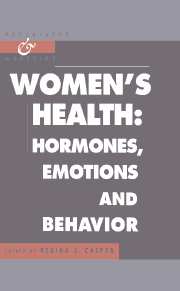Book contents
- Frontmatter
- Contents
- Preface
- 1 Growing up female
- 2 Reproduction and its psychopathology
- 3 Women's sexual function and dysfunction
- 4 Gender differences in brain morphology and in psychiatric disorders
- 5 Thyroid hormones in major depressive disorder and bipolar disorder
- 6 The hypothalamic-pituitary-adrenocortical system
- 7 The cost of starvation: Eating disorders
- 8 Coronary artery disease and women: Estrogens and psychosocial and lifestyle risk factors
- 9 The psychophysiology of breast cancer: Disease, hormones, immunity, and stress
- 10 The psychopharmacology of women
- 11 Intervention trials concerned with disease prevention in women
- References
- Index
7 - The cost of starvation: Eating disorders
Published online by Cambridge University Press: 08 February 2010
- Frontmatter
- Contents
- Preface
- 1 Growing up female
- 2 Reproduction and its psychopathology
- 3 Women's sexual function and dysfunction
- 4 Gender differences in brain morphology and in psychiatric disorders
- 5 Thyroid hormones in major depressive disorder and bipolar disorder
- 6 The hypothalamic-pituitary-adrenocortical system
- 7 The cost of starvation: Eating disorders
- 8 Coronary artery disease and women: Estrogens and psychosocial and lifestyle risk factors
- 9 The psychophysiology of breast cancer: Disease, hormones, immunity, and stress
- 10 The psychopharmacology of women
- 11 Intervention trials concerned with disease prevention in women
- References
- Index
Summary
Throughout history, famine has been imposed by both natural and human causes – by drought, locusts, war, poverty, or overpopulation – and to this day undernutrition and malnutrition are the major health problems in India and Africa.
By contrast, in the western hemisphere and increasingly in Asian nations, not undernutrition but overweight is causing health problems. Overconsumption of food has led to an increase in the incidence of obesity, non-insulin-dependent diabetes mellitus, hypertension, cardiovascular diseases, and eating disorders. Easy access to too much palatable food has had the paradoxical effect of self-imposed starvation: Dieting or deliberate food restriction has reached epidemic proportions, especially among female populations, who strive for thinness as their beauty ideal. Dieting in the form of semistarvation is currently the main trigger for the development of the two eating disorders, anorexia nervosa (AN) and bulimia nervosa (BN).
Both disorders are the products of a complex interplay of psychological and physiologic processes. They both belong to a group of heterogeneous psychiatric disorders that can have their onset in childhood, but typically occur during early to middle adolescence (AN) or late adolescence and young adulthood (BN).
AN is a rare but by no means novel disorder, with an incidence rate of 0.7–1.0/10,000/year for females and 0.05/10,000/year for males. Since 1960 an increasing number of new cases, in Denmark as high as 1.9/10,000/year for females and 0.17/10,000/year for males (Nielsen, 1990), have been observed.
Keywords
- Type
- Chapter
- Information
- Women's HealthHormones, Emotions and Behavior, pp. 122 - 149Publisher: Cambridge University PressPrint publication year: 1997

